Large Trees and Little Leaves…
Did you know that plants lose most of their water through their leaves? Some of you may remember this fact from their high school biology class. And if you somehow were able to remember anything from your high school biology class – I applaud you 😉 As for me, I did not remember this fact until I had to take more biology courses in college.
Alright, now back to my next question… Have you ever wondered how trees survive hot, dry conditions while still looking green and beautiful? Well, there are many trees like this growing naturally out in the desert and inside of your own garden.
Now, I will not go into a lecture about transpiration (loss of water from parts of the plant, especially leaves). But I will show you how some of my favorite trees survive the intense sun without losing all of their water.
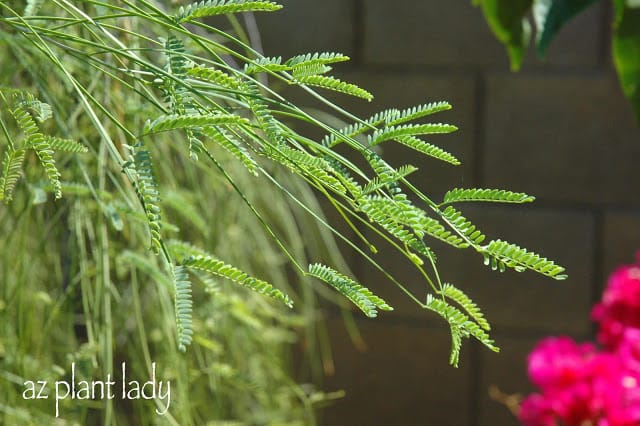
Palo Blanco (Acacia willardiana)
Take a look at the leaves of one of my favorite Acacia species. They are tiny, aren’t they?

Sweet Acacia (Acacia farnesiana)
The leaves of the Sweet Acacia are even tinier.
Some trees vary in the shape of small leaves that they produce. Some leaves are more round in their shape.
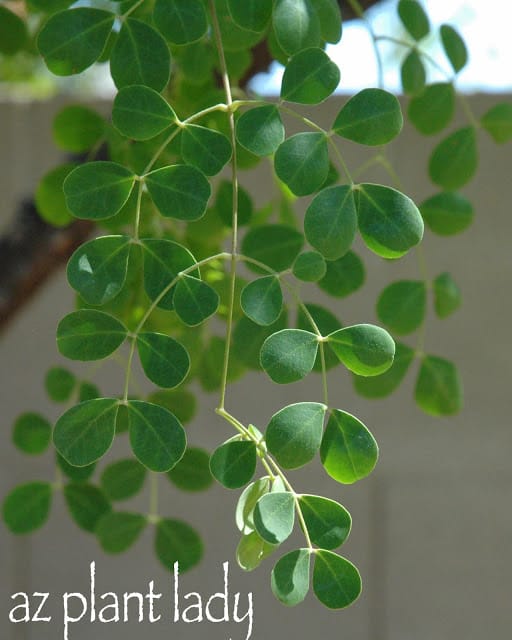
Cascalote (Caesalpinia cacalaco)
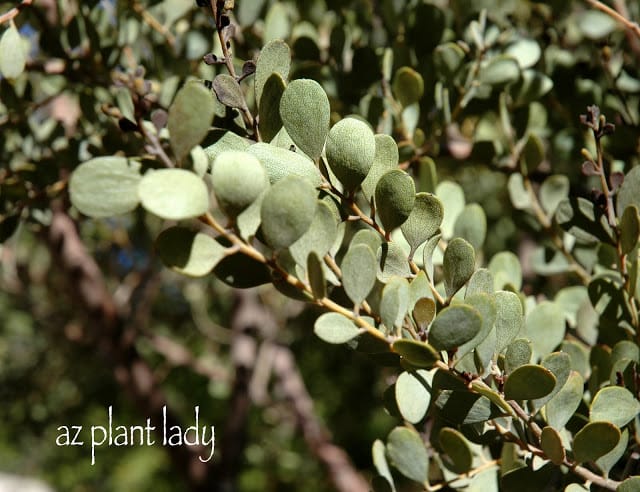
Leatherleaf Acacia (Acacia craspedocarpa)
Others are long and narrow.
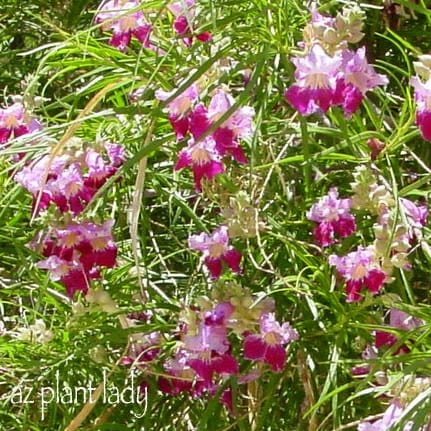
Desert Willow (Chilopsis linearis)

Weeping Wattle (Acacia saligna)
What all of these leaves have in common is that they limit the amount of water that is lost to the air.
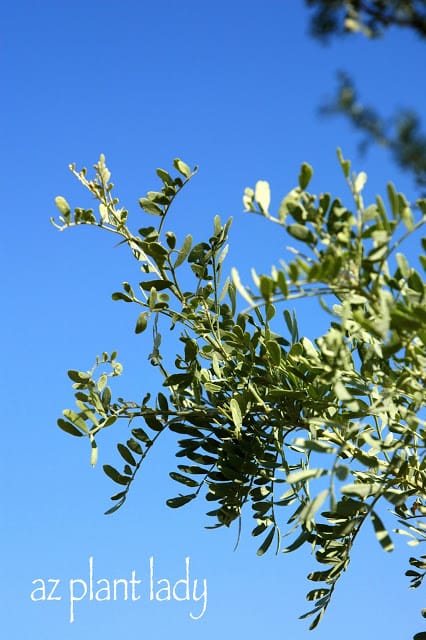
Ironwood (Olneya tesota)
How do they do this, you may ask? Well it turns out that the smaller the leaf, the less surface area that is exposed to the sun and air. And so as a result, there is less water lost to the atmosphere.
One way that the leaves help to hold on to their water is by having a tough cuticle (outer coating) that also cuts down on water loss. Another way is that many desert trees and plants are light green or gray in color. This helps the leaves to reflect more sunlight and heat.
Of course, trees with large leaves are grown quite successfully here in the desert and you will find many of them growing in the landscape.
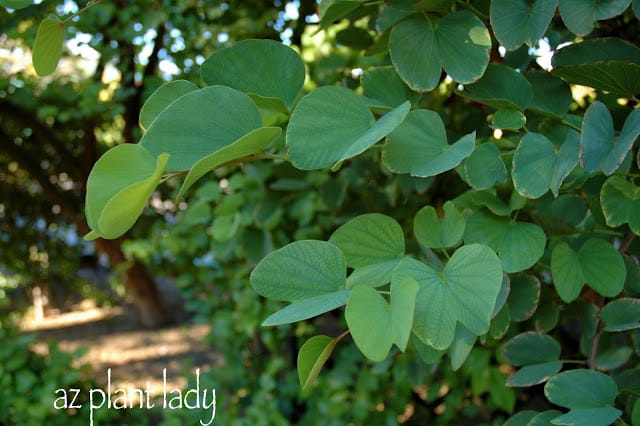
Orchid Tree (Bauhinia variegata)
Since we live in a semi-tropical environment, many trees from tropical areas thrive in our climate. They are largely characterized by large leaves.
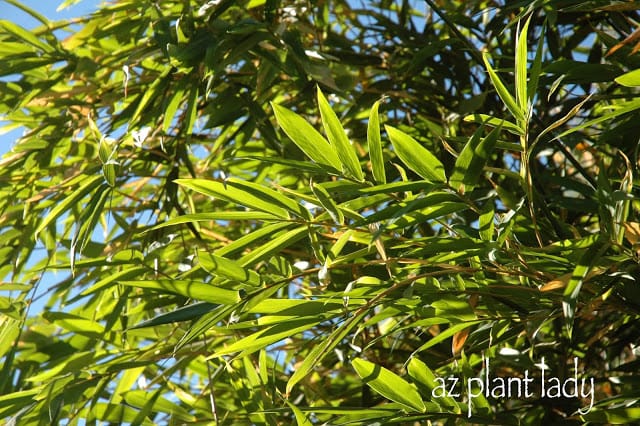
Bamboo
Some trees with large leaves require high amounts of water to grow since they lose so much water through their leaves. Now, I am not saying that you should not use trees that have larger leaves, but if you do decide to include them in your landscape, I would limit them to only a few and then plant more drought-tolerant trees as well.
Some of my other favorite drought tolerant trees that are not pictured are the Palo Verde, Texas Ebony, Eucalpytus and Mesquite.
Below, is one of my favorite desert trees, the Lysiloma, which is a perfect example of a tree adapted to our desert climate and is extremely drought tolerant – just look at the tiny leaves. They look somewhat like the fronds of a fern from far away.
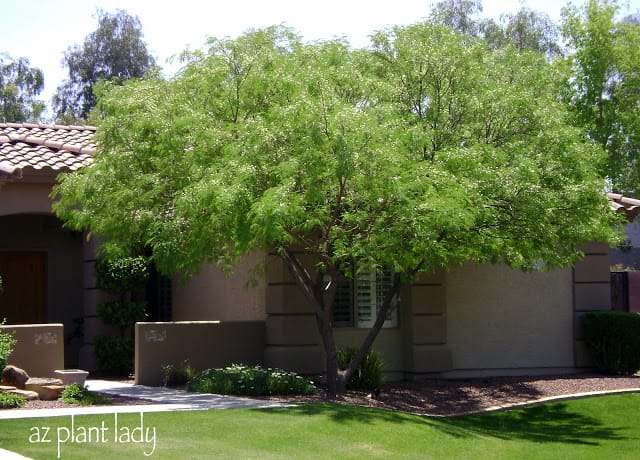
Lysiloma
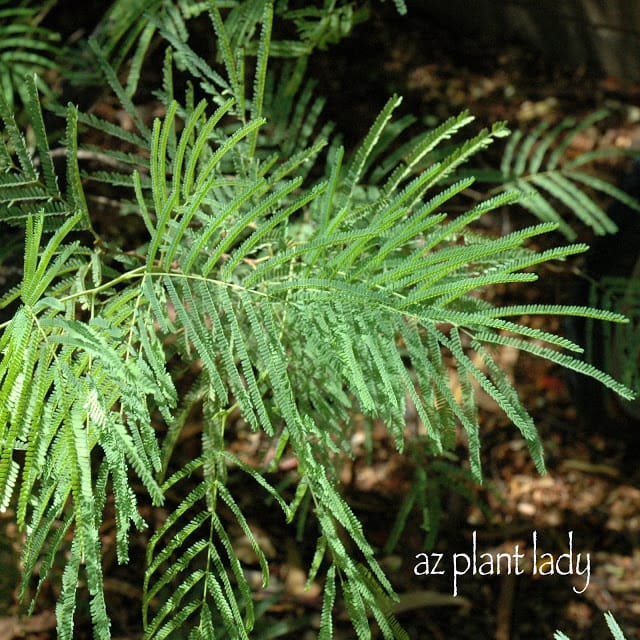
Lysiloma leaves
Some examples of trees that are known to be high water users are Cottonwood, Ash, Weeping Willow and Chinese Pistache trees.
For those of you who want to do all you can about conserving water in the landscape, I would recommend that you select trees that have smaller leaves and/or are known to be drought tolerant. You can find more trees listed and find out whether or not they are high or low water users at this helpful link.
I hope some of you find this information helpful.
Have a great day!

 Noelle Johnson, aka, 'AZ Plant Lady' is a author, horticulturist, and landscape consultant who helps people learn how to create, grow, and maintain beautiful desert gardens that thrive in a hot, dry climate. She does this through her consulting services, her online class Desert Gardening 101, and her monthly membership club, Through the Garden Gate. As she likes to tell desert-dwellers, "Gardening in the desert isn't hard, but it is different."
Noelle Johnson, aka, 'AZ Plant Lady' is a author, horticulturist, and landscape consultant who helps people learn how to create, grow, and maintain beautiful desert gardens that thrive in a hot, dry climate. She does this through her consulting services, her online class Desert Gardening 101, and her monthly membership club, Through the Garden Gate. As she likes to tell desert-dwellers, "Gardening in the desert isn't hard, but it is different."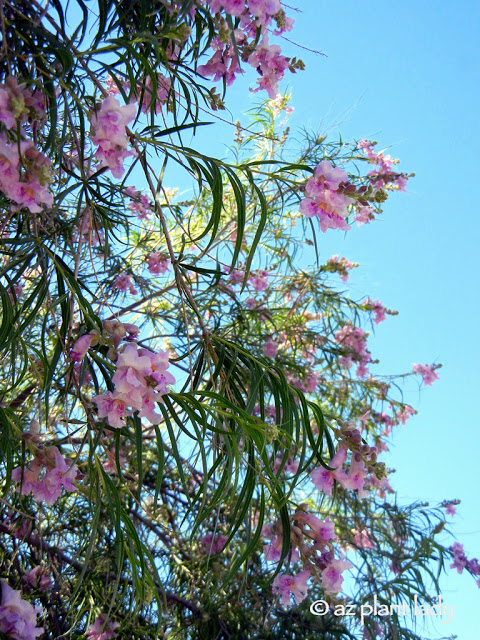
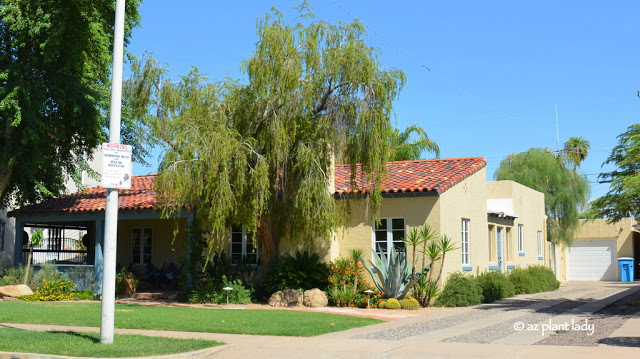
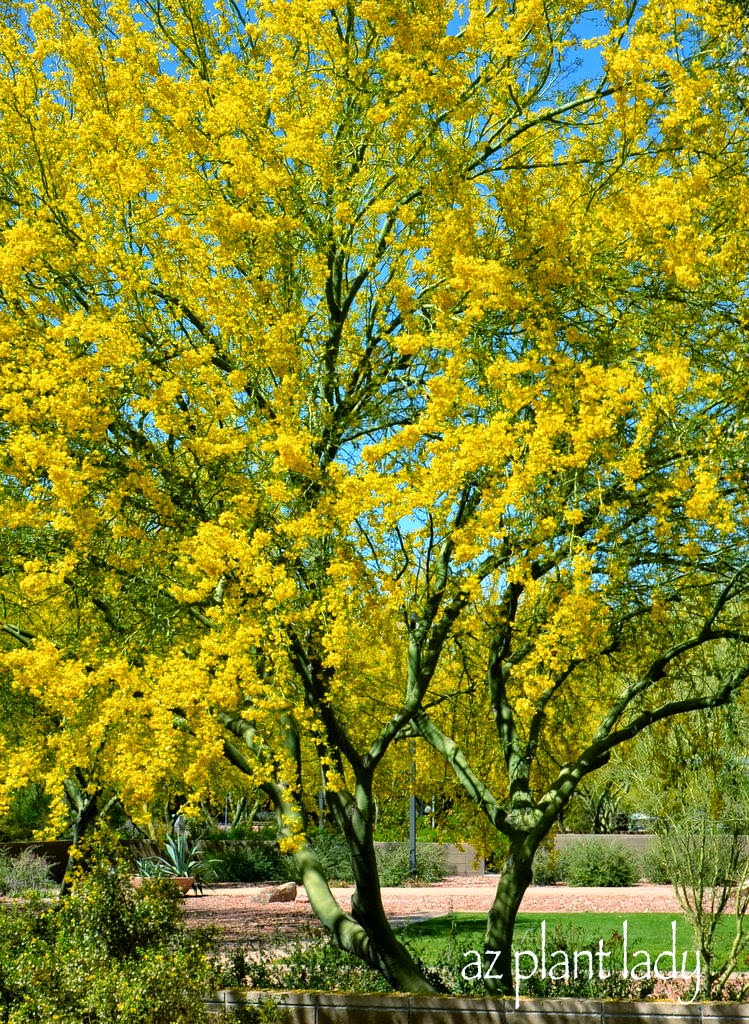
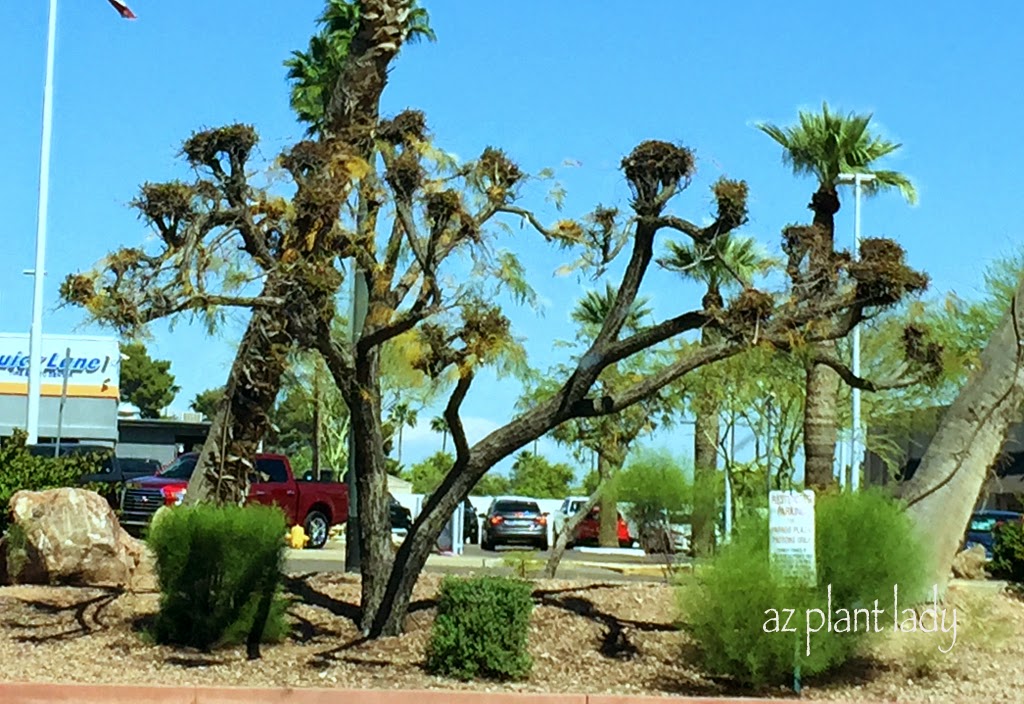
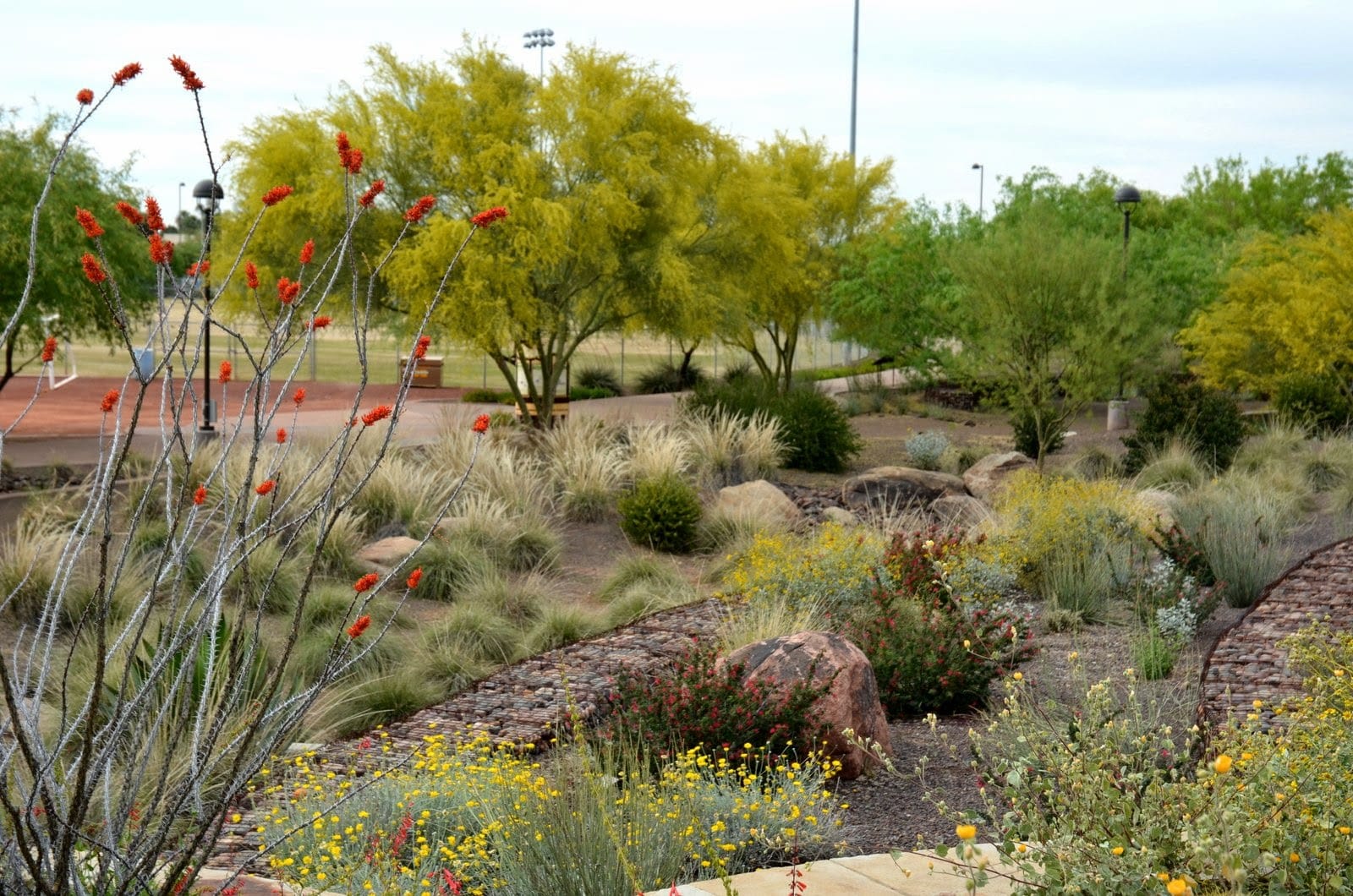
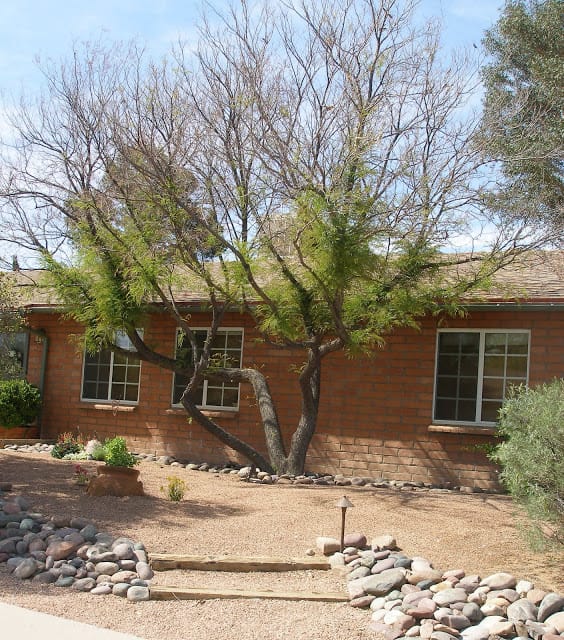









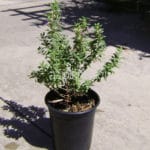
This was really interesting. The trees you show are just beautiful! I love the Acacias. The very last tree you show has the shape of a Japanese Maple, and the the leaves are so pretty.
The more you post, the more I'm wanting to move to Arizona!! 🙂
I like the acacias and the desert willow. We have those here, in the Texas Hill Country.
Mostly here, in our area, there is mesquite, live oaks, and cedar elms. All have those small leaves. I guess, that's the only way they've survived this long.
Great post.
~~Linda…
Dear Noelle, Yes, it vaguely rings a bell somewhere about trees and leaves. I also seem to remember something about most of one's body heat going out through one's head, but I may have that wrong.
Whatever, this was a very informative posting and I imagine that we shall all have to pay much more attention to drought tolerant plants in the future.
Nice post Noelle. Isn't it also the same reason that cacti have spines? I really like the appearance of the Lysiloma, from a distance. It reminds me of a mature Japanese maple in its form and structure, but obviously far more adapted to desert climate!
I remember almost nothing from high school! I love how educational your posts are – so much better than high school! I have a soft spot for desert willows, love the smell of those blossoms.
I agree, very interesting…thanks for taking the time to share it.
Wonderful post – I adore leaves more than anything, the pictures of the acacia, the Cascalote and the Lysiloma made my head spin and eyes bulge:-))
Have a nice evening!
Great post Noelle, though I am still stuck on my high school biology class…….I am sure I had biology, I must have. ?!?!?!
The first photo reminded me of the leaves of the Bald Cypress, which are also very tiny. Great information about water conservation in choice of tree plantings….and some new ones to me.
Hi Noelle…awesome post! I have always been fascinated wiht transpiration…wonderful read! Gorgeous photos too..so lush!! Have a happy day!
Kiki~
Noelle what beautiful photos and useful information.
Yes I had noticed the Hardenbergia Violecea in your garden and had been green with envy. My daughter keeps giving mine covetous looks but they are so expensive in our garden centre as they only have large plants. I will have another try at taking a cutting any tips.
Very interesting thoughts on drought-hardy plants. I do recognize many of those, such as the acacia and the orchid tree. Our orchid trees are in bloom all over right now, and they are so beautiful!
Beautiful photos and very interesting as well! Larry
Very informational post! I do remember I learned this from my highschool biology class 🙂 I love that desert willow, so beautiful! Like floridaGirl mentioned, orchid trees in our area has been in full bloom for over a month now. I even had a post about it, just gorgeous!
I haven't thought much about the small leaves/drought tolerant connection not living in those conditions. But now I see why the catalpa tree, with its enormous leaves, thrives in the NE. Very informative post, as always. And lovely pics, thank you.
I remember that one tree had all the tiny leaves on it and when it shed those leaves – all the leaves fall from the sky like tiny yellow rain…
Does that happen in your place?
Seeing our native plants thriving on your blog always makes me smile Noelle – that weeping wattle looks like home to me! Our recent drought over many years has led to quite a re-discovery of our hardy local species.
But I've been meaning to ask if some of our acacias and eucalypts are a problem where you are? I have heard that they have been quite invasive is some parts of the U.S.
Thanks for the botany lesson, Noelle. No, I don't remember much of anything from h.s. biology class:) But we did go over transpiration a few months ago in a crash course on botany in my MG classes, and I still don't remember learning this. Good points to remember when planting trees, especially with drought a problem in so many areas. I love the fern-like leaves on the Lysiloma.
I love the Lysiloma. Such a beautifully shaped tree. I love the leaves of the Cascalote too, and those bright cheery yellow flowers of the Weeping Wattle.
I did not remember this from high school biology!! It makes total sense tho ~ nature is a genius!!
A very informative post, with pretty pictures. I do remember learning about the adapatations plants make to conserve water, but it was probably in college that it sunk in. I've chosen mostly small-leaved trees for my yard for a different reason – less to rake up in the fall!
I love the ferny-looking leaves.
Hello and thank you for your comments. I appreciate them so much.
James,
We don't have trees that do that. We do have Palo Verde trees that produce a profusion of yellow flowers in the spring and then the flowers fall.
Hello Gippslandgardener,
We don't have problems with Eucalyptus or Acacia spreading too much because of our dry climate. If we had lots of rain like other climates, then I expect we would have problems.
Thank you for your questions!
Beautiful photos. I particularly like the cascalote, there's something so pleasing about the shape of those leaves. Yan
Noelle, this is exceptionally interesting! I can't say I've thought about leaf water loss, but it makes complete sense. I really like the little acacia leaves…so sweet! Does it close up like a mimosa?
Very informative post! I like your info about desert plants, because I know absolutely nothing about them. I do remember transpiration lectures in high school, but that's getting kind of far back these days…:)
Great post … I really enjoyed the information and photos you shared … it is fascinating stuff.
Of course, here in my part of the 'dry' world many of our eucalypts simply drop most of their larger leaves during out long dry spell. The bushland around me looks quite sparse during those months.
A wonderful post. Enjoy your week end.
fascinating… especially as your climate is so diferent from mine!